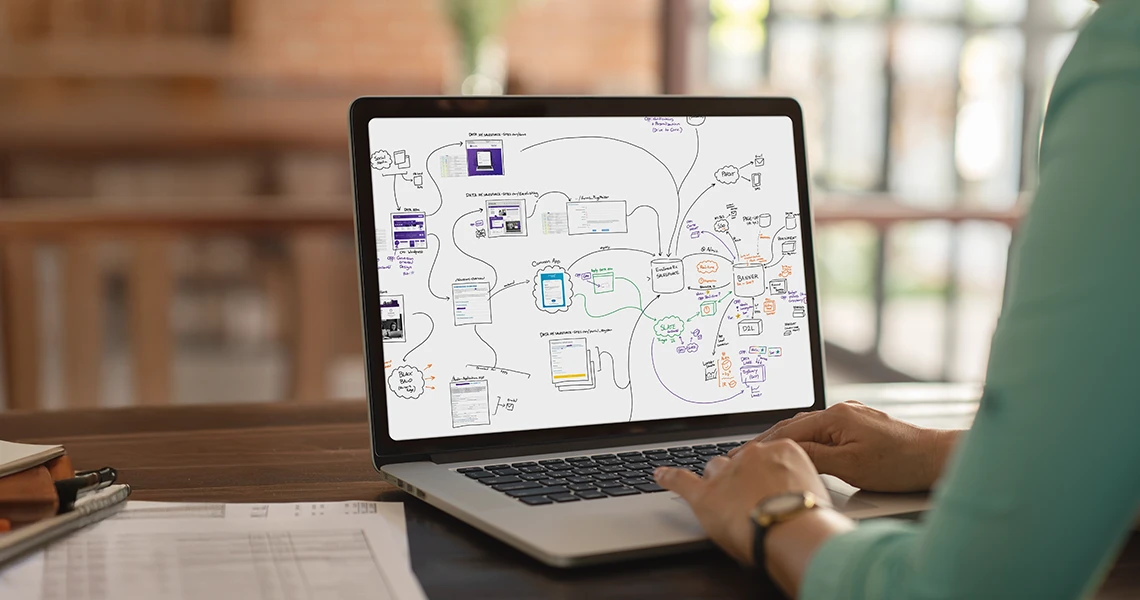The pace of change in marketing technology can be dizzying, particularly for colleges and universities that are navigating enrollment challenges, digital transformation, and shifting student expectations. As your institution evaluates its tech stack, partners, and strategic priorities, fluency in key marketing technology (MarTech) terms isn’t just helpful. It’s essential.
This glossary highlights 33 of the most relevant MarTech buzzwords for 2025 and beyond. Each term is defined with higher ed in mind, helping you decode the jargon and focus on what matters: reaching, enrolling, and retaining students more effectively.
The language of modern higher ed marketing
Consider this your cheat sheet for decoding today’s higher ed marketing terminology. Browse the buzzwords below, organized by topic.
Data & identity terms
First-party data
Information collected directly through your institution’s digital properties — like your website, CRM, or application portal — used for personalized and compliant outreach.
Zero-party data
Data students or prospects intentionally share, such as preferences, interests, or intended major, often gathered via forms or surveys.
Third-party data
Data acquired from external providers to supplement internal profiles, which is increasingly less reliable due to privacy regulations and cookie deprecation.
Cookieless tracking
Alternatives to third-party cookies, using first-party data or contextual signals to measure behavior and personalize experiences.
Student digital twin
A virtual representation of a student that consolidates academic, behavioral, and engagement data to personalize support and anticipate needs. Learn more.
Unified data architecture
An integrated framework that brings together siloed systems (CRM, SIS, LMS) into a cohesive data environment for analytics and action.
Data pipeline / ETL
“Extract, transform, load” (ETL) processes that move and prepare data between systems, ensuring accurate and timely flow across platforms.
Data trust/data hygiene
Ensuring your data is clean, consistent, and reliable — a foundation for accurate analytics and effective campaigns.
Data compliance
Adhering to legal and ethical standards for data collection, usage, and storage, which is critical for maintaining trust and avoiding penalties.
Data governance
The policies and standards that ensure institutional data is accurate, secure, and compliant with regulations like FERPA and GDPR.
GDPR (General Data Protection Regulation)
A European Union regulation that sets strict guidelines for collecting and managing personal data, influencing privacy standards worldwide.
AI & automation terms
Generative AI
Artificial intelligence that creates content (text, video, imagery) based on prompts and data inputs, increasingly used for marketing and student engagement.
Predictive analytics
Data models that forecast future behaviors, such as enrollment likelihood or student success risk, using historical and behavioral inputs.
Predictive modeling
A subset of predictive analytics that builds statistical models to anticipate outcomes, such as course success, stop-out risk, or inquiry-to-application conversion.
Lead scoring
Assigning values to prospective students based on behaviors and attributes to prioritize outreach and improve conversion.
Marketing automation
Tools that automate tasks like email sends, lead nurturing, and retargeting to deliver timely, personalized communication at scale.
Conversational AI
Chatbots and virtual assistants that engage users in real time, guiding inquiries and collecting data while reducing staff workload.
AI-driven personalization
Using machine learning to tailor experiences (like web content or email) based on user data and behavior.
Engagement scoring
Measuring how actively a student or lead is interacting with content to gauge interest and inform next steps.
Retention risk scoring
Modeling that identifies students likely to stop out based on early indicators, enabling timely support and intervention.
Ready for a Smarter Way Forward?
Higher ed is hard — but you don’t have to figure it out alone. We can help you transform challenges into opportunities.
Performance & optimization terms
Attribution modeling
Techniques for assigning credit to marketing touchpoints across the funnel, helping determine what’s driving conversions.
Return on investment (ROI)
Measuring the effectiveness of marketing efforts by comparing cost to revenue or outcomes generated.
Funnel optimization
Improving each stage of the enrollment funnel (from awareness to application) to increase yield and reduce friction.
A/B testing
Running controlled experiments between two versions of content or creative to identify what performs best.
Lift analysis
A method of measuring the incremental impact of a campaign or intervention by comparing it to a control group.
Real-time analytics
Instant access to performance data, allowing teams to adjust campaigns or communications on the fly.
Brand equity
The perceived value and trustworthiness of your institution’s brand, which influences enrollment decisions and marketing ROI. Learn about its importance in higher ed.
Experience, search & strategy terms
System integration
Connecting technology platforms (CRM, SIS, LMS, CMS) so data can flow across systems and support a seamless user experience.
Program viability modeling
Using market, enrollment, and financial data to assess which academic programs to invest in, optimize, or sunset. Learn more about academic portfolio strategy.
Behavioral segmentation
Grouping users based on their actions (like clicks, visits, or engagement) to enable more precise targeting.
Semantic search
Search engines increasingly rely on meaning and intent rather than keywords, making content structure and clarity more important than ever.
Structured data/schema markup
Code that helps search engines understand and categorize your content, improving visibility in search engines and AI search.
Cross-lifecycle marketing
Coordinating engagement strategies across the entire student lifecycle (from prospect to alumni) to build long-term relationships and lifetime value.
Looking ahead
Understanding MarTech terms isn’t about chasing trends. It’s about equipping your institution to make informed, future-ready decisions about technology, data, and strategy. Use this glossary as a reference point as you audit your tech stack, plan campaigns, or vet potential partners.
Ready to go deeper? Partner with Collegis to unlock the full power of your data and technology. Our marketing services and data expertise enable institutions to build smarter strategies, streamline their systems, and drive measurable growth in enrollment and student success.
Innovation Starts Here
Higher ed is evolving — don’t get left behind. Explore how Collegis can help your institution thrive.




![The Digital Twin: How to Connect and Enable Your Student Data for Outreach, Personalization, and Predictive Insights [Webinar]](https://blog.college-counseling.com/wp-content/uploads/2025/04/How-to-Unlock-Graduate-Enrollment-Growth-Webinar.webp.webp)
![How to Build a High-Impact Data Team Without the Full-Time Headcount [Webinar]](https://blog.college-counseling.com/wp-content/uploads/2025/06/How-to-Build-a-High-Impact-Data-Team-Without-the-Full-Time.jpg)





